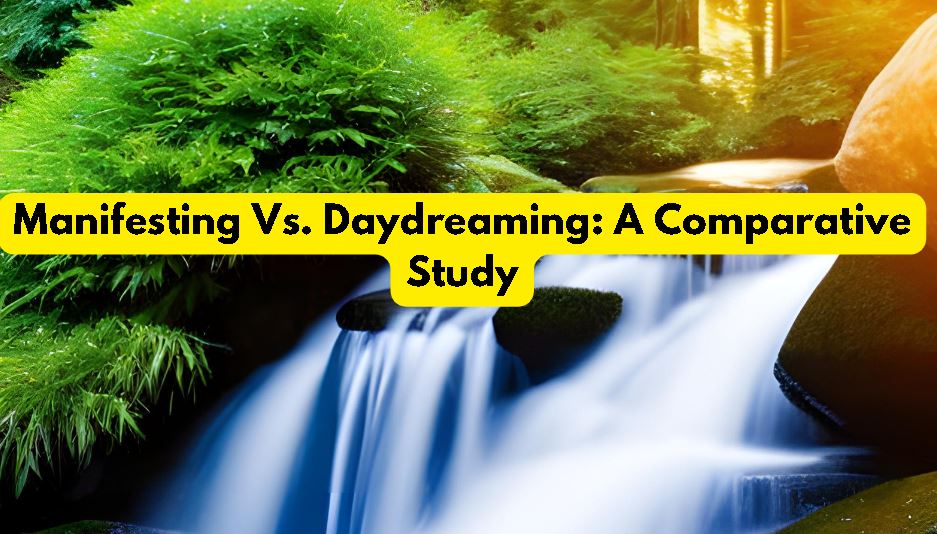Daydreaming and manifesting are two terms that are often used interchangeably in the realm of personal growth and self-help. While both involve visualization and imagination, they differ significantly in their underlying mechanisms and outcomes. In this article, we aim to compare and contrast the concepts of daydreaming and manifesting and provide insights into their effects on real life and psychological well-being.
What is Daydreaming and How Does it Affect Real Life?
Defining Daydreaming and its Characteristics

Daydreaming is a form of spontaneous and self-generated mental imagery that occurs when individuals are awake and alert. It is characterized by vivid and sensory-rich experiences that are disconnected from the external environment and may involve fantasies, memories, or future plans. Daydreaming can be triggered by various stimuli, such as boredom, stress, or internal curiosity. According to some researchers, daydreaming represents a form of spontaneous thinking that allows individuals to generate novel and creative ideas.
The Relationship Between Daydreaming and Real Life Behavior
The effects of daydreaming on real-life behavior have been a topic of interest in psychological research for many decades. Some studies suggest that daydreaming may enhance creativity, problem-solving, and self-reflection. In contrast, other studies indicate that excessive daydreaming may lead to distractibility, poor attentional control, and decreased satisfaction with real-life accomplishments. Moreover, maladaptive daydreaming, a subtype of daydreaming that involves compulsive and distressing fantasies, has been associated with symptoms of obsessive-compulsive disorder, depression, and anxiety.
Assessing Daydreaming: Criteria and Measures
Several measures have been developed to assess daydreaming and its effects on psychological functioning. One of the most commonly used questionnaires is the Imaginal Processes Inventory (IPI), which assesses the frequency, vividness, and content of daydreaming experiences. Another test that has been used to examine the relationship between daydreaming and real-life behavior is the Mind-Wandering Questionnaire (MWQ), which measures the frequency and content of mind-wandering experiences.
Is Daydreaming Always Creative?
Creative Daydreaming: Fact or Myth?
While daydreaming can be a source of creative insights and new ideas, not all forms of daydreaming are necessarily creative. Some forms of daydreaming may involve repetitive and escapist fantasies that provide temporary relief from stress but do not lead to meaningful change or growth. In contrast, creative daydreaming involves the generation of novel and useful ideas that can be applied to real-life problems or projects.
The Cognitive Mechanisms Behind Creative Daydreaming
The cognitive mechanisms underlying creative daydreaming are not well understood, although some studies suggest that it involves the activation of brain regions that are associated with imagery, attention, and cognitive flexibility. For example, functional magnetic resonance imaging (fMRI) studies have shown that creative daydreaming is associated with increased activity in the ventral and dorsal attention networks of the brain, which are involved in attentional control and cognitive processing.
Mind Wandering vs. Daydreaming: What’s the Difference?
Mind wandering and daydreaming are often used interchangeably, but they represent distinct cognitive processes. Mind wandering refers to the unintentional and spontaneous shift of attention from the current task or environment to internal thoughts, feelings, or sensations. In contrast, daydreaming refers to the intentional and self-generated production of mental imagery that is disconnected from the external environment. While both can be related to creativity, mind-wandering is more likely to involve negative emotions and rumination.
When Does Daydreaming Become Maladaptive?
The Concept of Maladaptive Daydreaming: Definition and Criteria
Maladaptive daydreaming is a subtype of daydreaming that involves excessive and compulsive fantasies that interfere with real-life functioning and cause distress or impairment. The concept of maladaptive daydreaming was first introduced in 2011 by a clinical psychologist named Eliezer Somer, who identified six criteria that can be used to diagnose this condition:
- Excessive time spent in daydreaming
- Prioritizing daydreaming over real-life activities and relationships
- Awareness of the daydreaming as a coping mechanism that interferes with functioning
- Difficulty controlling or stopping the daydreaming
- Distress, frustration or guilt related to daydreaming
- Significant impairment in social, academic, or occupational functioning
Characteristics and Behavioral Patterns of Maladaptive Daydreaming
Individuals with maladaptive daydreaming may experience vivid and detailed fantasies that are similar to the symptoms of dissociative disorders. However, unlike dissociation, maladaptive daydreaming is typically triggered by internal or external stimuli and involves a subjective sense of control over the content and direction of the fantasy. Some studies have suggested that maladaptive daydreaming may be related to a history of childhood trauma or abuse, although this finding is not conclusive.
Assessment and Treatment of Maladaptive Daydreaming
The assessment and treatment of maladaptive daydreaming are still in the early stages of development, partly due to the lack of consensus on its definition and diagnostic criteria. Some approaches that have been used to address this condition include cognitive-behavioral therapy (CBT), exposure therapy, and medication. However, more research is needed to determine the effectiveness of these and other interventions.
Can Daydreaming and Fantasy Reveal Insights into the Mind?
The Use of Daydreaming and Fantasy in Psychological Research
Daydreaming and fantasy have been used as tools for psychological research and the exploration of unconscious processes since the time of Freud and Jung. In particular, they have been used as a means of accessing and revealing the contents of the unconscious mind and the symbolic meanings of dreams and fantasies. While these methods have been criticized for their subjective and speculative nature, some researchers have suggested that they can provide valuable insights into the individual’s inner world and psychological functioning.
Imagery and Cognitive Function: How Daydreaming Correlates to Brain Activity
Research on the brain correlates of daydreaming and imagery has yielded interesting findings about their relationship to cognitive function and brain activity. For example, studies have shown that individuals who are high in visual imagery ability, a trait associated with vivid and immersive mental imagery, have greater activity in the parietal and temporal regions of the brain during daydreaming and imagination tasks. Other studies have suggested that the frequency and content of daydreaming experiences can be correlated with individual differences in working memory, attentional control, and creativity.
The Existence of Maladaptive Daydreaming as a Symptom or Condition: Science vs. Fiction
While maladaptive daydreaming has been proposed as a distinct psychological condition, some researchers have challenged its validity and suggested that it may represent a symptom or manifestation of other underlying psychopathologies. For example, some have suggested that maladaptive daydreaming may be related to obsessive-compulsive disorder, dissociative disorder, or depression. More research is needed to examine the underlying mechanisms and clinical relevance of maladaptive daydreaming and its relationship to other psychological conditions.
How is Manifesting Different from Daydreaming?
The Concept of Manifesting and its Characteristics
Manifesting is a term that is used to describe the intentional and focused visualization of desired outcomes or goals. It involves the use of mental imagery, affirmations, and positive emotions to create a state of alignment between the individual’s thoughts, feelings, and actions. While daydreaming is more spontaneous and unstructured, manifesting is more intentional and structured.
Interaction Between Daydreaming and Manifesting
Daydreaming and manifesting can be viewed as complementary processes that involve different levels of intentionality and control. Daydreaming can provide a source of creative inspiration and new ideas, which can then be channeled into manifesting through intentional goal-setting and visualization. At the same time, manifesting can provide a sense of purpose and direction to daydreaming, by focusing it on specific and meaningful goals.
Q: What is the difference between manifesting and daydreaming?
A: Manifesting is the intentional creation of a desired outcome, whereas daydreaming is simply imagining a desired outcome without taking any action towards it.
Q: Is manifesting a real phenomenon?
A: There is no scientific evidence to support the idea that manifesting is a real phenomenon. However, many people believe in it and claim to have experienced its effects.
Q: Can manifesting be dangerous?
A: Manifesting itself is not dangerous, but it can become obsessive and lead to an inability to focus on anything else, which may be a cause for concern.
Q: What is the role of psychology in manifesting?
A: Psychology plays a key role in manifesting as it involves changing one’s belief system and mental habits in order to achieve a desired outcome.
Q: Is there any scientific journal that has published a report on manifesting?
A: To the best of our knowledge, there has been no scientific journal that has published a report on manifesting as it is not a recognized scientific phenomenon.
Q: What impact does a drug have on manifesting?
A: There is no evidence to suggest that drugs have any impact on manifesting.
Q: Who is the author of the book ‘Manifesting vs daydreaming a comparative study’?
A: The author of the book ‘Manifesting vs daydreaming a comparative study’ is unknown.
Q: Does manifesting involve any kind of motion or physical activity?
A: No, manifesting is a mental process that does not involve any kind of motion or physical activity.
Q: Is manifesting discussed in any particular scientific volume or publication?
A: No, manifesting is not recognized as a scientific phenomenon, and as such, is not discussed in any particular scientific volume or publication.
Q: Can manifesting be adopted as a talent or a skill?
A: Yes, manifesting can be adopted as a talent or a skill through consistent practice and the use of various techniques.
A Note on Manifesting: Abstract vs. Object-Oriented
Manifesting can take different forms depending on whether it is abstract or object-oriented. Abstract manifesting involves the visualization of abstract concepts such as happiness, abundance, or success, while object-oriented manifesting involves the visualization of specific objects or situations such as a new job, a healthy relationship, or a dream vacation. Both forms of manifesting can be effective in creating positive changes in one’s life, although some individuals may find object-oriented manifesting more concrete and tangible.
In conclusion, while daydreaming can be a healthy outlet for creativity and imagination, excessive and maladaptive daydreaming can be a sign of a psychological condition that requires assessment and treatment. On the other hand, manifesting is a different concept altogether that involves a more intentional approach to visualization and goal-setting. Both daydreaming and manifesting can reveal insights into the






Leave a Reply